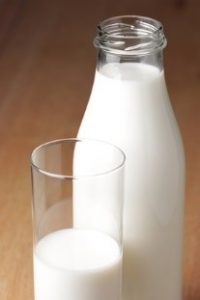Can You Have Your Cream And Eat It Too?
Author: Dr. Stephen Chaney
 Dairy foods can play an important role in helping us get enough calcium in our diet and may provide some other benefits (discussed below). However, many dairy foods contain a lot of saturated fat. Thus, we have been told to select low-fat dairy foods. So, what should we make of the recent headlines and blogs telling us that high-fat dairy foods are good for us?
Dairy foods can play an important role in helping us get enough calcium in our diet and may provide some other benefits (discussed below). However, many dairy foods contain a lot of saturated fat. Thus, we have been told to select low-fat dairy foods. So, what should we make of the recent headlines and blogs telling us that high-fat dairy foods are good for us?
Are high fat dairy foods good for us?
To answer that question, I picked a recent article (F. Imamura et al, PLOS Medicine, doi: 10.1371/journal.pmed.1002670 ) claiming that dairy fats lower the risk of type 2 diabetes and did an in-depth analysis of the data behind the headlines.
Fat Chemistry 101
Before I get started, let me cover what I call “Fat Chemistry 101”. Sorry, professors never fully retire.
 Fat Nomenclature: Let me briefly describe some of the nomenclature that chemists and biochemists use when they describe fats. Fats, or triglycerides, are generally defined as three fatty acids attached to a molecule of glycerol. The chemical nomenclature for fatty acids consists of a “C” followed by the number of carbons in that fatty acid. That, in turn, is followed by a colon (:) and the number of doubles bonds (0 for a saturated fatty acid, 1 for a monounsaturated fatty acid, and 2 or more for a polyunsaturated fatty acid). Let me give some examples, specifically the examples I will refer to in this article.
Fat Nomenclature: Let me briefly describe some of the nomenclature that chemists and biochemists use when they describe fats. Fats, or triglycerides, are generally defined as three fatty acids attached to a molecule of glycerol. The chemical nomenclature for fatty acids consists of a “C” followed by the number of carbons in that fatty acid. That, in turn, is followed by a colon (:) and the number of doubles bonds (0 for a saturated fatty acid, 1 for a monounsaturated fatty acid, and 2 or more for a polyunsaturated fatty acid). Let me give some examples, specifically the examples I will refer to in this article.
Saturated fatty acids:
- C15:0 (pentadecanoic acid)
- C16:0 (palmitic acid)
- C17:0 (heptadecanoic acid)
- C18:0 (stearic acid)
Monounsaturated fatty acids:
- C18:1 (oleic acid)
C16:0, and C18:0 are referred to as even-chain fatty acids (They have an even number of carbon atoms). C15:0 and C17:0 are referred to as odd-chain fatty acids (They have an odd number of carbon atoms).
C16:0 (palmitic acid) is the most abundant saturated fatty acid in meats and dairy food. C18:0 (stearic acid) is the second most abundant saturated fatty acid in these foods. The odd-chain fatty acids C15:0 and C17:0 are primarily found in dairy fat although small amounts can also be found in meat and fish.
All saturated fats raise LDL cholesterol. However, the effect is not equally strong for all saturated fats. The effect on LDL cholesterol is strongest for palmitic acid (C16:0). It is weaker for stearic acid, possibly because stearic acid (C18:0) can be metabolized to oleic acid (C18:1), which has no effect on LDL cholesterol.
Foods Are A Complex Mixture Of Fats: We generally think of saturated fats coming from meat and dairy, monounsaturated fats coming from olive oil and avocados, and polyunsaturated fats as coming from vegetable oils, seeds, and nuts. However, that is an oversimplification. Meats also contain monounsaturated and polyunsaturated fats. Olive oil contains some saturated and polyunsaturated fats. Vegetable oils also contain monounsaturated and saturated fats.
Why do I even mention this? It is important because we tend to label a food “good” or “bad” based on its most abundant fat. Perhaps we would be better served if we considered all the major fats in that food before deciding whether it is good or bad for us.
How Was The Study Designed?
 With that background in mind, let us turn our attention to the current study. The authors wished to test the hypothesis that high-fat dairy foods might decrease the risk of type 2 diabetes. The results of previous studies had been mixed, but the authors hypothesized that might have been due to the limitations of using dietary recalls to assess intake of high-fat dairy foods. Specifically, they theorized that dietary recalls tend to underestimate the less apparent sources of dairy fats such as creams, sauces, cheeses, and butter used as part of meal preparation or in prepared foods.
With that background in mind, let us turn our attention to the current study. The authors wished to test the hypothesis that high-fat dairy foods might decrease the risk of type 2 diabetes. The results of previous studies had been mixed, but the authors hypothesized that might have been due to the limitations of using dietary recalls to assess intake of high-fat dairy foods. Specifically, they theorized that dietary recalls tend to underestimate the less apparent sources of dairy fats such as creams, sauces, cheeses, and butter used as part of meal preparation or in prepared foods.
They postulated that blood and tissue concentrations of the odd-chain fatty acids (C15:0 and C17:0) would be a much better biomarker of dairy fat consumption than dietary recalls. They performed a meta-analysis of all studies that measured blood or tissue levels of odd-chain fatty acids and looked at type 2 diabetes as an outcome.
Their meta-analysis included 16 studies from 12 countries with a total of 63,682 participants (age range: 49 to 76 years). The participants were slightly overweight, but none of them had type 2 diabetes at the beginning of the studies. The participants were followed for an average of 9 years. By the end of the studies 15,180 (24%) had developed type 2 diabetes.
Are High Fat Dairy Foods Good For You?
 When the authors compared the highest versus the lowest levels of odd-chain fatty acids in the subjects, the results of the study were as follows:
When the authors compared the highest versus the lowest levels of odd-chain fatty acids in the subjects, the results of the study were as follows:
- The highest level of C15:0 fatty acids was associated with a 20% lower incidence of type 2 diabetes.
- The highest level of C17:0 fatty acids was associated with a 35% lower incidence of type 2 diabetes. This is consistent with several previous studies that have suggested C17:0 fatty acids are a better predictor of type 2 diabetes than C15:0 fatty acids.
- When these data were combined the overall effect was a 29% lower incidence of type 2 diabetes.
The authors concluded: “These novel findings support the need for additional clinical and molecular research to elucidate the potential effects of [odd-chain] fatty acids on glucose-insulin metabolism and the potential role of selected [high-fat] dairy products for the prevention of type 2 diabetes.”
What Does This Study Mean For You?
 On the surface, this looks like a very strong study. It is, after all, a meta-analysis with over 68,000 subjects. It also used biomarkers for dairy fat consumption rather than relying on less accurate dietary recalls. Finally, it is consistent with several earlier studies suggesting that high-fat dairy foods decrease the risk of type 2 diabetes and heart disease. What could go wrong?
On the surface, this looks like a very strong study. It is, after all, a meta-analysis with over 68,000 subjects. It also used biomarkers for dairy fat consumption rather than relying on less accurate dietary recalls. Finally, it is consistent with several earlier studies suggesting that high-fat dairy foods decrease the risk of type 2 diabetes and heart disease. What could go wrong?
The answer is “Plenty.”
- Studies looking at the effect of high-fat dairy foods on the risk of heart disease and type 2 diabetes have been inconsistent. Some have shown benefit, but others have come up empty. Despite the inconsistent results, the idea that high-fat dairy foods might be good for us has gotten a lot of media attention. I suspect that is because this is the kind of news we really want to be true. After all, wouldn’t it be great news if we could eat all the cheese, cream, and butter we wanted?
- Some studies have concluded that high-fat and low-fat dairy products were equally effective at decreasing the risk of heart disease and type-2 diabetes. If these studies are correct, they would suggest something else in dairy foods is protective, not the kind of fat.
- The odd-chain saturated fatty acids are very minor constituents of dairy fat. Together, they represent 1.3% of the fatty acids in dairy fat. In contrast, even-chain saturated fatty acids make up 68% of the fatty acids in dairy fat. Palmitic acid (C16:0) makes up 30% or 23 times the concentration of odd-chain fatty acids. Stearic acid (C18:0) makes up 12% or 9 times the concentration of odd-chain fatty acids.
- This study, and most previous studies, have just looked at the association between odd-chain fatty acids and type 2 diabetes. They do not prove cause and effect.
- No mechanism has been proposed that would account for the proposed beneficial effects of odd-chain saturated fatty acids, especially in the presence of much higher concentrations of even-chain saturated fatty acids.
- A study published last year (BJ Jenkins et al, Scientific Reports, 7:44845, doi: 10.1038/srep44845 ) reported that blood levels of C15:0 were dependent on intake of dairy foods, but that blood levels of C17:0 were independent of dairy intake. These authors presented evidence showing C17:0 in the human body resulted from metabolism of C18:0 (stearic acid) in our diet rather than coming from dairy fats.
In other words, the odd-chain fatty acid (C15:0) that comes from dairy foods is the one that has only a weak association with the risk of developing type 2 diabetes. The odd-chain fatty acid with a strong association with diabetes risk is synthesized in our bodies from stearic acid (C18:0), a fatty acid that is also found at high levels in meat.
So, are high fat dairy foods good for you? More studies are needed.
The Bottom Line
A recent study has reported that high-fat dairy products may reduce the risk of type 2 diabetes. This is consistent with a few other studies that have suggested high-fat dairy products may reduce the risk of diabetes and heart disease.
The idea that high-fat dairy foods might be good for us has gotten a lot of media attention. I suspect that is because this is the kind of news we really want to be true. After all, wouldn’t it be great news if we could eat all the cheese, cream, and butter we wanted?
However, the clinical results have been inconsistent. Some have shown benefit, but others have come up empty. Most of the studies also had significant limitations. I have discussed the limitations of the current study in the article above.
We can remain hopeful that high-fat dairy foods will eventually be shown to be good for us, but until we have stronger evidence for the proposed benefits of dairy fats, my recommendation is to consume high-fat dairy products sparingly.
For more details read the article above.
These statements have not been evaluated by the Food and Drug Administration. This information is not intended to diagnose, treat, cure or prevent any disease.
